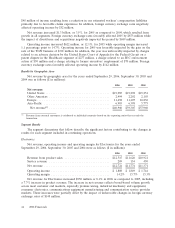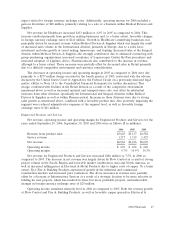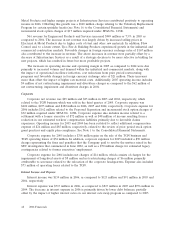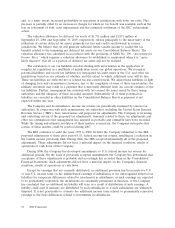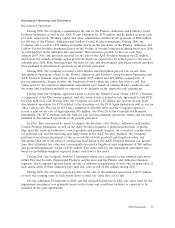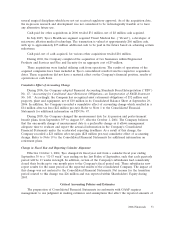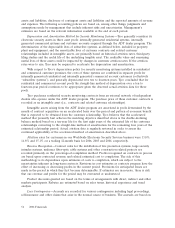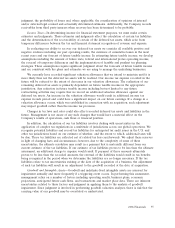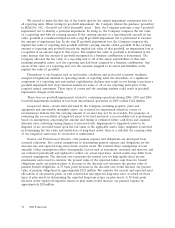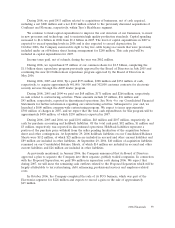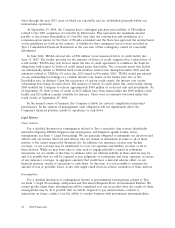ADT 2006 Annual Report Download - page 116
Download and view the complete annual report
Please find page 116 of the 2006 ADT annual report below. You can navigate through the pages in the report by either clicking on the pages listed below, or by using the keyword search tool below to find specific information within the annual report.assets and liabilities, disclosure of contingent assets and liabilities and the reported amounts of revenue
and expenses. The following accounting policies are based on, among other things, judgments and
assumptions made by management that include inherent risks and uncertainties. Management’s
estimates are based on the relevant information available at the end of each period.
Depreciation and Amortization Method for Security Monitoring Systems—Tyco generally considers its
electronic security assets in three asset pools: internally generated residential systems, internally
generated commercial systems and customer accounts acquired through the ADT dealer program. The
determination of the depreciable lives of subscriber systems, as defined below, included in property,
plant and equipment, and the amortizable lives of customer contracts and related customer
relationships included in intangible assets, are primarily based on historical attrition rates, third-party
lifing studies and the useful life of the underlying tangible asset. The realizable value and remaining
useful lives of these assets could be impacted by changes in customer attrition rates. If the attrition
rates were to rise, Tyco may be required to accelerate the depreciation and amortization.
With respect to Tyco’s depreciation policy for security monitoring systems installed in residential
and commercial customer premises, the costs of these systems are combined in separate pools for
internally generated residential and internally generated commercial account customers (collectively
‘‘subscriber systems’’), and generally depreciated over ten to fourteen years. Tyco concluded that for
residential and commercial account pools the straight-line method of depreciation over a ten to
fourteen-year period continues to be appropriate given the observed actual attrition data for these
pools.
Tyco purchases residential security monitoring contracts from an external network of independent
dealers who operate under the ADT dealer program. The purchase price of these customer contracts is
recorded as an intangible asset (i.e., contracts and related customer relationships).
Intangible assets arising from the ADT dealer program are amortized in pools determined by the
month of contract acquisition on an accelerated basis over the period and pattern of economic benefit
that is expected to be obtained from the customer relationship. Tyco believes that the accelerated
method that presently best achieves the matching objective described above is the double-declining
balance method based on a ten-year life for the first eight years of the estimated life of the customer
relationships converting to the straight-line method of amortization for the remaining four years of the
estimated relationship period. Actual attrition data is regularly reviewed in order to assess the
continued applicability of the accelerated method of amortization described above.
Attrition rates for customers in our Worldwide Electronic Security Services business were 13.8%,
14.8% and 15.1% on a trailing 12-month basis for 2006, 2005 and 2004, respectively.
Revenue Recognition—Contract sales for the installation of fire protection systems, large security
intruder systems, undersea fiber-optic cable systems and other construction related projects are
recorded primarily on the percentage-of-completion method. Profits recognized on contracts in process
are based upon contracted revenue and related estimated cost to completion. The risk of this
methodology is its dependence upon estimates of costs to completion, which are subject to the
uncertainties inherent in long-term contracts. Revisions in cost estimates as contracts progress have the
effect of increasing or decreasing profits in the current period. Provisions for anticipated losses are
made in the period in which they first become determinable. If estimates are inaccurate, there is risk
that our revenue and profits for the period may be overstated or understated.
Product discounts granted are based on the terms of arrangements with direct, indirect and other
markets participants. Rebates are estimated based on sales terms, historical experience and trend
analysis.
Loss Contingencies—Accruals are recorded for various contingencies including legal proceedings,
self-insurance and other claims that arise in the normal course of business. The accruals are based on
54 2006 Financials


